 Passengers traveling to vacation destinations around the Midwest, as well as those seeking fresh air, relaxation, and entertainment on board, departed on pleasure cruises on the Great Lakes in great numbers beginning in the the late 19th century. They sailed off towards such promises as “one week of delightful pleasure and two thousand miles of blue sky and water” on longer tours; shorter, evening excursions likewise offered entertainment, fresh air, and, if one’s timing was right, perhaps a view of a World’s Fair. Cruise operators began to see a decline in passenger travel as the popularity of the automobile shifted vacationers away from the steamers and into cars beginning in the 1920s, though many continued operations well through the first half of the twentieth century.
Passengers traveling to vacation destinations around the Midwest, as well as those seeking fresh air, relaxation, and entertainment on board, departed on pleasure cruises on the Great Lakes in great numbers beginning in the the late 19th century. They sailed off towards such promises as “one week of delightful pleasure and two thousand miles of blue sky and water” on longer tours; shorter, evening excursions likewise offered entertainment, fresh air, and, if one’s timing was right, perhaps a view of a World’s Fair. Cruise operators began to see a decline in passenger travel as the popularity of the automobile shifted vacationers away from the steamers and into cars beginning in the 1920s, though many continued operations well through the first half of the twentieth century.
The 1930 Detroit & Cleveland Navigation Co. pamphlet shown at left borrows from the imagery of Transatlantic passenger travel, promising a less-expensive and less time-consuming version of that glamour for travelers closer to home. Indeed, some of these Great Lakes steamers featured some of the luxuries and many of the entertainments of larger ships: live music performed by full orchestras, floor shows, sumptuous dining, and lavishly-appointed cabins, parlors, and dining rooms.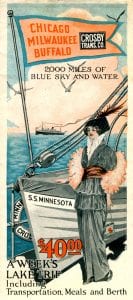
The Inland Water Pamphlets collection at Northwestern University’s Transportation Library illustrates the history of the Great Lakes passenger steamships with 78 pamphlets from some 40 companies, dating from 1890 to 1972.
Week-long cruises, such as those operated by the Crosby Transportation Company, allowed passengers the choice of staying aboard for the duration of their journey, or departing at ports of call along the way including Mackiniac Island, Buffalo, and Milwaukee, then resuming their journey at any time during the season. The company promised fresh air and a cool, refreshing vacation to those departing the heat and dust of the city during the summer on the S.S. Minnesota, a steamship built in 1911. The Minnesota featured such amenities as electric lights, running water, and a large refrigerating plant that kept perishables in cold storage for table use, thereby enabling the creation of “good, wholesome meals, well cooked and served in the most appetizing manner.” The luxurious steamer featured a dancing pavilion, open air palm garden, and daily concerts. “If there are dull moments,” the brochure read, “you alone will be to blame.”
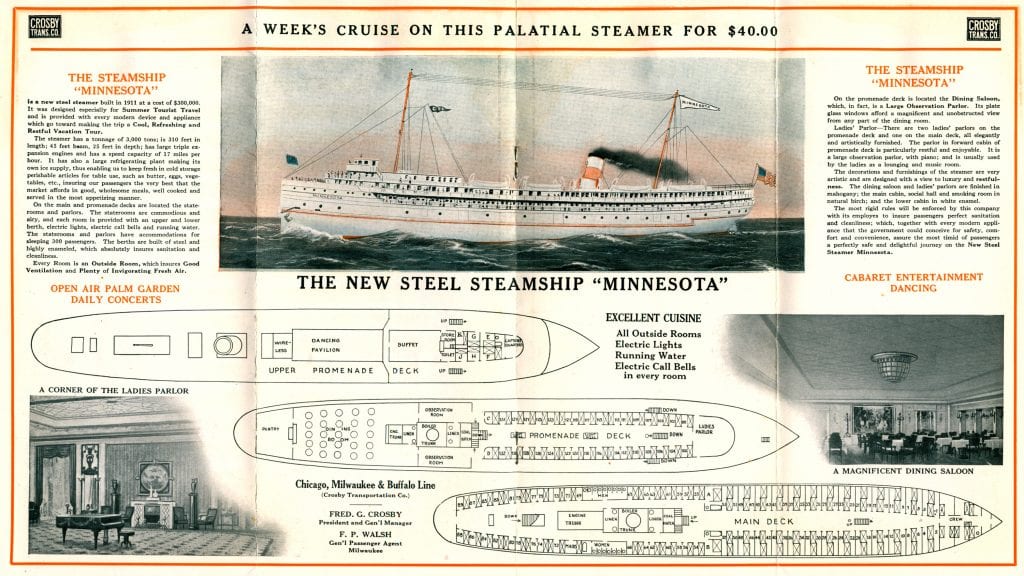
Many of these routes, such as the Pennsylvania Railroad’s Anchor Line, were operated by railroads to complement their rail services and connect terminals in 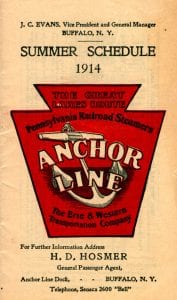 the Great Lakes region. The Anchor Line’s 1914 summer schedule is shown here, and lists passenger service connecting Buffalo, Duluth, and points in between. Fares ranged from $1.50 for the Buffalo-to-Erie route, up to $11.00 to travel from Buffalo to Duluth. A 10-day cruise on the line was promoted as “the cheapest, most delightful, and most restful trip in the world.”
the Great Lakes region. The Anchor Line’s 1914 summer schedule is shown here, and lists passenger service connecting Buffalo, Duluth, and points in between. Fares ranged from $1.50 for the Buffalo-to-Erie route, up to $11.00 to travel from Buffalo to Duluth. A 10-day cruise on the line was promoted as “the cheapest, most delightful, and most restful trip in the world.”
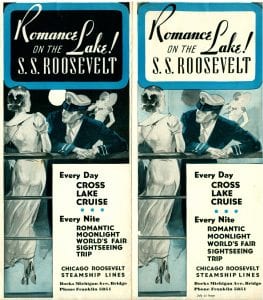 Already by the 1930s, the increasing popularity of automobile travel meant a decline in passenger travel on Great Lakes steamships as they were gradually replaced by car trips. Operators like the Chicago Roosevelt Steamship Company included language about convenience and cost benefits in their advertising: “Why Drive … Avoid Congested Highways.” Crowds, extra hazards, and traffic delays were some of the woes, the company warned, that threatened those who chose to drive – though passengers could also take their cars on the ship at low rates.
Already by the 1930s, the increasing popularity of automobile travel meant a decline in passenger travel on Great Lakes steamships as they were gradually replaced by car trips. Operators like the Chicago Roosevelt Steamship Company included language about convenience and cost benefits in their advertising: “Why Drive … Avoid Congested Highways.” Crowds, extra hazards, and traffic delays were some of the woes, the company warned, that threatened those who chose to drive – though passengers could also take their cars on the ship at low rates.
In 1933 and 1934, lake cruises promoted the chance to see the Chicago Century of Progress World’s Fair, which took place on the Lake Michigan shoreline on the city’s near south side. The Chicago Roosevelt Steamship Lines was one operator offering World’s Fair cruises, departing from the south end of the Michigan Avenue Bridge nightly at 9:45 and returning two hours later. The cruise experience was complete with a lecturer who pointed out points of interest along the way: “Beautiful terraces of greensward bedecked with sparkling light, illuminated multicolored modernistic World’s Fair structures—a rainbow of beauty several miles in length.”

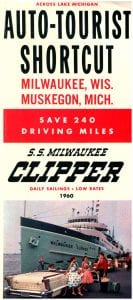 Later in this period, companies advertised their ships as time savers for auto travelers, as in the case of the S.S. Milwaukee Clipper, carrying 900 passengers and 120 automobiles on an “Auto-Tourist Shortcut” across Lake Michigan from Milwaukee to Muskegon, as illustrated in the 1960 pamphlet shown here. The promise of carefree fun on the 6-hour journey included shuffleboard, cocktail lounges, a children’s playroom, theater, and several dining options – and, importantly, a savings of 240 driving miles. Passengers departing from Milwaukee left through the Municipal Passenger and Automobile Pier on the lakefront and arrived, presumably, relaxed and ready to tour the resorts of western and northern Michigan via automobile.
Later in this period, companies advertised their ships as time savers for auto travelers, as in the case of the S.S. Milwaukee Clipper, carrying 900 passengers and 120 automobiles on an “Auto-Tourist Shortcut” across Lake Michigan from Milwaukee to Muskegon, as illustrated in the 1960 pamphlet shown here. The promise of carefree fun on the 6-hour journey included shuffleboard, cocktail lounges, a children’s playroom, theater, and several dining options – and, importantly, a savings of 240 driving miles. Passengers departing from Milwaukee left through the Municipal Passenger and Automobile Pier on the lakefront and arrived, presumably, relaxed and ready to tour the resorts of western and northern Michigan via automobile.
For more on the Inland Water Pamphlets collection, view the Finding Aid online or contact the Northwestern University Transportation Library at 847-491-5273 or transportationlibrary@northwestern.edu. This collection is available to view by appointment.
